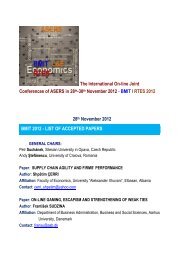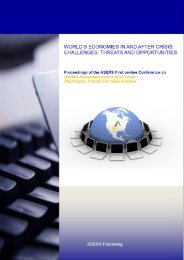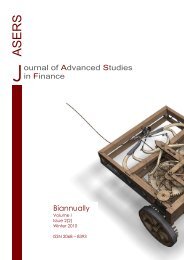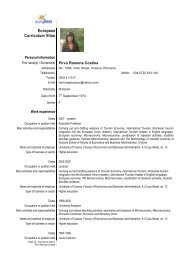Can Shift to a Funded Pension System Affect - ASERS
Can Shift to a Funded Pension System Affect - ASERS
Can Shift to a Funded Pension System Affect - ASERS
Create successful ePaper yourself
Turn your PDF publications into a flip-book with our unique Google optimized e-Paper software.
Theoretical and Practical Research in Economic Fields<br />
the balance of payments, closing the gap between China and the USA will be faster and, more importantly,<br />
cheaper in terms of lost welfare. This said, measuring trade in value added may, as in this case, reduce bilateral<br />
imbalances, but in other instances it will increase it, or even change its sign (Daudin et al. 2009; Johnson, and<br />
Noguera 2009). From a balance of payments perspective, the overall imbalance of an economy vis-à-vis the rest<br />
of the world will remain the same.<br />
Measuring bilateral trade flows according <strong>to</strong> their domestic content modifies also the responses <strong>to</strong> bilateral<br />
exchange rates adjustments. In the previous example (Table 2), an appreciation of the Chinese Yuan vis-à-vis<br />
the US dollar will only be transmitted <strong>to</strong> the price of Chinese exports in proportion <strong>to</strong> their domestic content (50%<br />
in average). Thus, a revaluation of the Yuan would influence only moderately the bilateral balance with the USA,<br />
albeit it still may lead <strong>to</strong> a lower overall trade surplus for China, especially by increasing its <strong>to</strong>tal demand for<br />
imports.<br />
• Global Effective Demand<br />
Even if some bilateral imbalances may prove easier <strong>to</strong> resolve, it remains that the rebalancing will imply<br />
for the deficit countries higher national savings, <strong>to</strong> be obtained through a relative decrease in final demand and an<br />
improved competitiveness <strong>to</strong> generate net exports. These forces will lead <strong>to</strong> fundamental changes in the source<br />
of global effective demand, from “old industrialized West” <strong>to</strong> “emerging East” 31 . The implications for the<br />
industrialization prospects of other developing countries may depend more strongly on their geographical<br />
situation (distance from the emerging markets) and their existing production potential. As mentioned in Box 2, for<br />
developing countries that will remain outside regional production networks, it may be feared that rebalancing from<br />
North-South <strong>to</strong> South-South trade will be determined largely by absolute comparative advantages. Such an exit<br />
scenario implies, at least for the medium term, a relative reduction in the international demand for labour intensive<br />
manufactured consumer goods (clothing, textile and consumer electronics) and an increase in demand for<br />
commodities (agricultural, fuels and minerals) and investment goods.<br />
Adjusting <strong>to</strong> this trend will prove especially difficult for the less-advantaged countries (i.e. resourceconstrained<br />
small developing countries, especially the least-developed countries). According <strong>to</strong> WTO (2010)<br />
developed economies remain largely the dominant LDCs‟ export destination for manufactured articles such as<br />
clothing (95%) and some high value-added agricultural and food products (between 60 and 70%). For these<br />
developing countries suffering usually from high trade deficit, the external situation may worsen as the potential<br />
for exporting labour intensive products <strong>to</strong> the North would decline in the same time as their import bill in oil and<br />
food will increase.<br />
Even for resource-rich less-advantaged countries, which have been benefiting from the increase in<br />
commodity prices during the 2000s, the long term impact on development is not clear, as exporting nonrenewable<br />
commodities does not have the same social benefits than exporting labour-intensive merchandises<br />
and is non-sustainable in the long term. For these countries, the challenge is <strong>to</strong> manage their natural resource<br />
bonanza in a sustainable way, but it is not an easy course of action, considering the pressing needs of their<br />
population.<br />
Confronted <strong>to</strong> such a perspective, there are basically two trade-related options opened <strong>to</strong> less-advantaged<br />
countries. One is <strong>to</strong> lower the costs of exporting. These costs are part of the supply constraints that frequently<br />
reduce the international competitiveness of LDCs and limit their trade potential. Based on World Bank estimates<br />
(Doing Business, 2009), time for exporting a standardized cargo of goods by ocean transport was 37 days for<br />
LDCs, against a world average of 25 (less than 12 days in the case of developed countries). According <strong>to</strong><br />
Djankov et al. (2006), a one-day reduction in delays before a cargo sails <strong>to</strong> its export destination is equivalent <strong>to</strong><br />
reducing the distance <strong>to</strong> trading partners by about 70 km. The issue is even made more pressing by the “distance<br />
puzzle” or “missing globalization puzzle” (the negative effect of distance on international trade is not shrinking as<br />
expected, despite technological changes) for poor countries. Carrère et al. (2010) estimates that low income<br />
countries exhibit a significant rising distance effect on their trade, around 18 percent between 1970 and 2006.<br />
While part of the effect could be attributed <strong>to</strong> the impact of regional trade agreements, the growing importance of<br />
vertical specialization and tightly managed global supply chains under just-in-time production increase the<br />
opportunity cost of time and distance. In this case, low–income countries that face relatively larger costs could be<br />
marginalized from global trends.<br />
31 "Emerging East" is an illustrative concept which includes some western hemisphere countries, like Brazil or<br />
Mexico. The concept of effective demand refers <strong>to</strong> a demand-driven model, where production responds <strong>to</strong> final demand and<br />
where some large importing countries (typically the USA and the EU in the pre-crisis scenario) play the role of world<br />
locomotive.<br />
38











